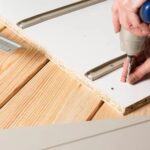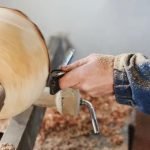Are you a woodworking enthusiast wondering, “What kind of respirator do I need for woodworking?” Woodworking can produce a variety of airborne particles and gases that can be harmful if inhaled. In this article, we will discuss the importance of wearing a respirator while woodworking and understanding the different types of respirators available for this purpose.
Woodworking involves various processes such as sanding, cutting, and finishing that can generate fine dust, fumes, and other airborne contaminants. Without proper protection, these particles can pose serious health risks to your respiratory system. This is why wearing a respirator is crucial to protect yourself from inhaling harmful substances. In this section, we will delve into the reasons why wearing a respirator is essential when working with wood.
In addition to highlighting the potential health risks of not using a respirator while woodworking, we will also provide insights into factors to consider when choosing a respirator for woodworking. From filter type to fit and comfort, it’s important to select the right respirator that suits your specific needs and preferences.
As we continue with this article, we will explore the recommended respirator options based on individual requirements and offer tips for proper maintenance and care of your respirator for extended use.
Understanding the Different Types of Respirators Available for Woodworking
When it comes to woodworking, wearing a respirator is crucial for protecting yourself from the harmful effects of wood dust and other airborne particles. There are several types of respirators available, each with its own characteristics and level of protection. Understanding the different types of respirators will help you choose the best one for your woodworking needs.
The following are the main types of respirators available for woodworking:
- N95 Respirators: These disposable respirators are designed to filter out 95% of airborne particles, making them suitable for most woodworking tasks that produce fine wood dust.
- Half-Mask Respirators: These respirators cover the nose and mouth and are equipped with filters to protect against wood dust. They offer better protection than N95 respirators and can be more comfortable to wear for extended periods.
- Full-Face Respirators: These provide the highest level of protection as they cover the entire face and include eye protection. They are ideal for more intensive woodworking tasks that produce heavy amounts of wood dust or when working with chemicals.
It’s important to consider various factors when choosing a respirator for woodworking, such as the type of filters it uses, how well it fits your face, and how comfortable it is to wear for long periods. Additionally, consider if you need additional features such as eye protection or compatibility with other safety equipment.
Understanding the different types of respirators available will help you make an informed decision on what kind of respirator you need for woodworking. By considering your specific needs and preferences, you can ensure that you have the right level of protection while working with wood.
Factors to Consider When Choosing a Respirator for Woodworking (Eg Filter Type, Fit, Comfort)
When selecting a respirator for woodworking, there are several factors to consider ensuring that you have the right level of protection. One crucial aspect to keep in mind is the filter type. Particulate filters are essential for woodworking as they can effectively capture wood dust and other fine particles that may be harmful when inhaled. Look for respirators with N95, N99, or N100 ratings to ensure adequate filtration of airborne particles.
Another important factor is the fit of the respirator. A proper seal around your nose and mouth is critical for preventing inhalation of harmful substances. Respirators with adjustable straps and/or cushioning around the nose area can help ensure a snug and secure fit.
Comfort is also key when choosing a respirator, as you will likely be wearing it for extended periods while working on woodworking projects. Look for respirators made of lightweight materials and those with comfortable straps to minimize discomfort during use.
Not all respirators are created equal, so it’s essential to do your research and find one that meets your specific needs and preferences. Whether you prefer disposable or reusable options, there are various choices available on the market. It’s important to choose a respirator that not only provides adequate protection but also fits comfortably and suits your personal preferences.
| Factor | Considerations |
|---|---|
| Filter Type | N95, N99, or N100 ratings; particulate filters |
| Fit | Proper seal; adjustable straps; cushioning around nose area |
| Comfort | Lightweight materials; comfortable straps |
Recommended Respirator Options for Woodworking Based on Specific Needs and Preferences
When it comes to woodworking, choosing the right respirator is crucial for protecting yourself from harmful dust, fumes, and other particles. There are several different types of respirators available, each with its own strengths and weaknesses. To determine what kind of respirator you need for woodworking, it’s important to consider factors such as filter type, fit, and comfort.
One option for woodworking respirators is the N95 disposable respirator. These are lightweight and economical, making them a popular choice for many woodworkers. They offer protection against particulates in the air, but they may not be as comfortable for extended wear as other options.
Another choice is a half-face respirator with replaceable filters. These offer a more customizable fit and provide protection against both particulates and organic vapors. The replaceable filters also make these respirators a cost-effective option in the long run.
For those who require maximum protection, a full-face respirator may be the best choice. These cover the entire face and offer protection against a wider range of hazards, including chemical fumes and gases. Although they tend to be more expensive and heavier than other options, they provide the highest level of safety.
It’s important to carefully evaluate your needs and preferences when selecting a woodworking respirator. Consider factors such as the duration of your woodworking projects, the type of wood you work with, and any specific health concerns you may have. Taking these factors into account will help you choose the best respirator for your unique requirements.
| Respirator Type | Key Features |
|---|---|
| N95 Disposable Respirator | Lightweight and economical; offers protection against particulates |
| Half-Face Respirator with Replaceable Filters | Customizable fit; protects against particulates and organic vapors; cost-effective with replaceable filters |
| Full-Face Respirator | Covers entire face; offers protection against chemical fumes and gases; provides highest level of safety |
The Potential Health Risks of Not Using a Respirator While Woodworking
Woodworking can be a fulfilling and enjoyable hobby or profession, but it also comes with potential health risks, particularly to the respiratory system. Not using a respirator while woodworking can expose you to various hazardous substances that can have long-term effects on your health. Here are some of the potential health risks of not using a respirator while woodworking:
- Inhalation of Wood Dust: Wood dust contains tiny particles that can easily become airborne during woodworking activities. Inhaling wood dust over time can lead to respiratory issues such as asthma, bronchitis, and even lung cancer.
- Exposure to Chemicals in Stains and Finishes: Many woodworking projects involve the use of stains, paints, varnishes, and other finishes that contain harmful chemicals. Breathing in these fumes can cause dizziness, nausea, headaches, and in severe cases, damage to the nervous system.
- Risk of Allergic Reactions: Some types of wood such as oak, walnut, and mahogany can cause allergic reactions when their dust is inhaled. This can result in skin rashes, nasal congestion, coughing, and wheezing.
It’s important to understand that these potential health risks are not to be taken lightly. This is why choosing the right respirator for woodworking is crucial for protecting your respiratory system from harm. Whether you’re a beginner or an experienced woodworker, knowing what kind of respirator you need for woodworking is essential in safeguarding your health.
Tips for Proper Maintenance and Care of Your Respirator
Proper maintenance and care of your respirator is crucial to ensure its effectiveness and longevity. Neglecting the maintenance of your respirator can compromise its ability to filter out harmful particles, putting your respiratory health at risk. Here are some essential tips for maintaining and caring for your respirator when woodworking.
Regular Cleaning
After each use, it is important to clean your respirator thoroughly to remove any sawdust, particles, or other contaminants that may have accumulated on the mask. Use a mild detergent and warm water to wash the mask and straps, making sure to remove any residue. Once cleaned, allow the respirator to air dry completely before storing it.
Replace Filters as Needed
The filters in your respirator need to be replaced regularly to ensure optimal protection. Check the manufacturer’s recommendations for how often you should replace the filters based on your level of use. If you notice increased difficulty breathing through the mask or a lingering odor while wearing it, it is likely time to replace the filters.
Storage
When not in use, store your respirator in a clean, dry place away from direct sunlight and extreme temperatures. Proper storage will help prolong the life of your respirator and prevent damage to its components.
By following these maintenance tips, you can ensure that your respirator continues to provide effective protection while woodworking and extend its lifespan. Remember that proper care and maintenance are essential for getting the most out of your investment in a quality respirator tailored specifically for woodworking needs.
How to Properly Fit and Wear a Respirator for Maximum Protection
When it comes to woodworking, wearing a respirator is essential for protecting your lungs from harmful dust particles and other airborne contaminants. However, in order to ensure maximum protection, it’s important to properly fit and wear your respirator. This section will provide valuable information on how to do just that.
Choose the Right Size
The first step to properly fitting a respirator is choosing the right size. To determine the correct size for your face, you can refer to the manufacturer’s guidelines or try on different sizes to see which one provides the best fit. A properly fitted respirator should create a seal around your nose and mouth without any gaps.
Perform a Seal Check
Before using your respirator, it’s crucial to perform a seal check to ensure that it is providing proper protection. There are different methods for performing a seal check depending on the type of respirator you have. It’s important to follow the specific instructions provided by the manufacturer in order to verify that your respirator is sealed correctly.
Wear It Comfortably
In addition to achieving a proper fit, it’s also important to wear your respirator comfortably. This means adjusting the straps and ensuring that there are no pressure points causing discomfort on your face. Some respirators come with adjustable features that allow for a customized fit, so take advantage of these options for maximum comfort and protection.
By following these guidelines for properly fitting and wearing a respirator, you can greatly reduce your exposure to harmful airborne particles while woodworking and ensure the protection of your respiratory health in the workshop.
Additional Safety Measures to Consider in Addition to Wearing a Respirator While Woodworking
In conclusion, understanding the importance of wearing a respirator while woodworking is crucial for protecting your respiratory health. Whether you are sanding, sawing, or working with chemicals and solvents, airborne particles and fumes can pose serious health risks if inhaled. By choosing the right kind of respirator for woodworking, you can effectively reduce your exposure to these hazards and minimize the potential for long-term respiratory issues.
When it comes to selecting a respirator for woodworking, there are several factors to consider, such as the type of filters required for the specific contaminants you will be exposed to, the fit and comfort of the respirator, and any additional features that may improve its effectiveness. Taking the time to assess your needs and preferences will help you choose a respirator that provides optimal protection without sacrificing comfort.
In addition to wearing a respirator while woodworking, it’s important to implement other safety measures to further reduce your risk of exposure to harmful substances. This may include proper ventilation in your workspace, using dust collection systems and wearing appropriate protective gear such as gloves and eye protection. By incorporating these additional measures along with wearing a respirator, you can create a safer environment for woodworking while prioritizing your overall well-being.
Frequently Asked Questions
Is N95 Enough for Woodworking?
N95 masks are generally considered sufficient for woodworking, as they are designed to filter out 95% of airborne particles. However, some woodworkers may choose to use more heavy-duty respirators with replaceable cartridges for additional protection against sawdust and other fine particles.
Should You Wear a Respirator When Woodworking?
It is highly recommended to wear a respirator when woodworking, especially when working with power tools that create fine dust. Sawdust can contain harmful substances such as formaldehyde or other toxic chemicals from pressure-treated wood. A respirator will help protect the lungs from inhaling these particles.
What Kind of Mask to Wear for Woodworking?
The best kind of mask to wear for woodworking is a well-fitting N95 respirator or a more heavy-duty respirator with replaceable cartridges specifically designed for filtering out sawdust and other airborne particles. These masks should be able to seal properly around the nose and mouth to prevent inhalation of harmful particles while working with wood.

Hi everyone! I’m a woodworker and blogger, and this is my woodworking blog. In my blog, I share tips and tricks for woodworkers of all skill levels, as well as project ideas that you can try yourself.





